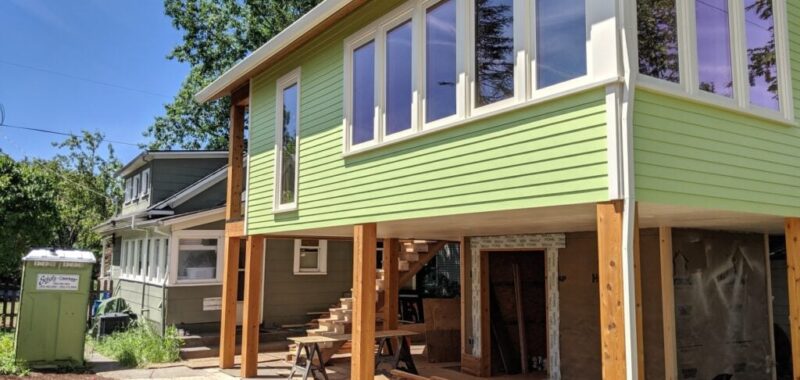
Whether it’s refining your business model, mastering new technologies, or discovering strategies to capitalize on the next market surge, Inman Connect New York will prepare you to take bold steps forward. The Next Chapter is about to begin. Be part of it. Join us and thousands of real estate leaders Jan. 22-24, 2025.
As wildfires rage across California, destroying over 9,000 homes and displacing thousands of residents, accessory dwelling units (ADUs) have emerged as a critical housing solution five years after being approved in Los Angeles.
ADUs, also known as granny flats, in-law apartments or casitas, are independent living spaces attached to or located on the same property as single-family homes. According to Zillow, they can take various forms, including stand-alone structures, home additions or converted basements or garages.
These units have become a vital alternative source of housing stock, especially in times of crisis.
California’s wildfire crisis began last Tuesday due to a combination of drought, Santa Ana winds and months without rainfall, California Fire Advisor Alison Deak said.
Deak explained the unusual timing of these conditions, stating, “We have the Santa Ana winds, which are not unusual, and we have drought which is not unusual, but they’ve kind of come together at this time of year when we expect it not to occur.”
The fires, which began in Pacific Palisades, have spread to multiple zones, including Eaton, Hurst, Lidia, Kenneth and Sunset. While the Sunset fire has been contained, firefighters are still battling the others.
The wildfire crisis has also compounded California’s pre-existing housing shortage. Shelton Wilder, a Los Angeles-based luxury Realtor, described the dire situation.
“Thousands of people have lost their homes and need a place to live. We already had a housing shortage, and now a lot of them are uninhabitable.
“This is apocalyptic. Nothing has ever been like this,” Wilder said.
In response to the devastation, many displaced residents are turning to ADUs for shelter even as officials open temporary shelters.
ADUs can provide a number of benefits for homeowners, offering the potential for generating rental income, maximizing property value and, as in the current crisis, creating alternative housing solutions, especially during emergencies.
Legal changes pave the way for more California ADUs
Kendyl Young, a California-based broker-owner, writer and speaker on the topic of ADUs, says the units represent the largest segment of residential properties approved within the past two years. Young attributes this to a number of factors, including newer ADU rules and increased demand due to high housing costs and dwindling supply.
According to California architecture firm EZ Plans, recent legal changes have made it easier to both build and utilize ADUS:
- Unpermitted ADUs can be approved if they meet health and safety standards. Local agencies must provide a checklist of required repairs and cannot charge penalties, impact fees or connection fees if no new utility connections are needed.
- Property owners can build up to eight detached ADUs on multi-family lots if they don’t exceed the number of units in the dwelling and meet setback and height requirements. They can be constructed in uncovered parking areas without requiring replacement parking.
- By July 1, 2026, the California Coastal Commission will provide guidelines to simplify the ADU permitting process in coastal zones.
These reforms build on earlier legislation from 2019, which spurred an 88 percent increase in ADU permits between 2019 and 2022, bringing the number of units from 5,852 to 17,460, according to the Cato Institute.
Due to the wildfires, rents will likely skyrocket, Young said, which will last for years as it will take the LA County Building department (and all associated agencies) more time to approve new construction to replace destroyed housing.
While ADUs are a practical solution, their construction costs can be significant. Custom-built detached units in San Jose, California, for example, may cost $250,000, while retrofitting existing spaces can range from $80,000 to $150,000. Fixed expenses, such as excavation and foundation work, contribute to higher prices.
Homeowners have options for financing, including FHA-backed loans, cash-out refinancing, second mortgages and home equity lines of credit.
According to Young, ADUs were originally expected to serve the “missing middle,” with lower-cost rentals in more expensive neighborhoods. However, increased demand will likely elevate those prices.
“The wildfires will likely spike demand to the point where all rental housing, ADUs included, will be at peak prices,” Young said.
“I am exhausted and heartsick,” Young continued. “While my home is safe, I know too many clients, friends and colleagues who have lost their homes. “
Wilder’s team, the Shelton Wilder Group, has been working nonstop to place between 30 and 40 clients. According to Wilder, the team has been sharing resources, even when they were unable to help clients directly.
Wilder herself has relocated from Brentwood where the flames are still burning. Support from friends and even clients has helped her through the crisis.
In the meantime, President Joe Biden’s Major Disaster declaration has unlocked federal resources to aid affected communities.
For those living in areas not yet directly affected by the wildfires, Deak emphasizes the importance of proactive emergency planning:
- Stay updated on weather conditions
- Avoid spark-prone activities, such as smoking in dry areas
- Sign up for mobile alerts
- Pack a go-bag with essentials
“Fire is going to happen in Southern California,” Deak said. “Think about what we can do to prepare for these events.”
Email Richelle Hammiel

